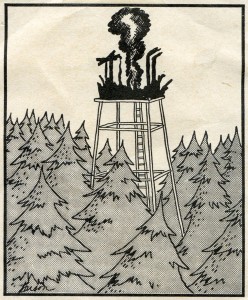 Gary Larson, the biologist-meets-comic cartoonist who created The Far Side, caught fire with the public because of his unique juxtaposition of the universe versus our little lives. This cartoon of a smoldering fire lookout has always been one of my favorites. No words. Just visual irony.
Gary Larson, the biologist-meets-comic cartoonist who created The Far Side, caught fire with the public because of his unique juxtaposition of the universe versus our little lives. This cartoon of a smoldering fire lookout has always been one of my favorites. No words. Just visual irony.
I saw a lot of these forest service towers growing up the in the Pacific Northwest. Can you imagine having the place burn down on your watch as you vigilantly survey the miles of evergreens through your binoculars while your chicken noodle soup boils over and short circuits your hot plate setting your post ablaze? Talking about not seeing the forest for the trees.
Humankind’s survey of space, with our rockets that go up and our telescopes that look out, focuses on the forest of interstellar bodies in our universe. However, one forward looking NASA project called Landsat, a network of surveying satellites launched in 1984, turned the observation lens back toward Earth. Over the past 30 years, Landsat has recorded the impact the human species has been having on our planet.
Google has recently worked with NASA to clean up and stitch together the satellite photos, and created videos to give us all a visual journey of the entropy we’re causing to our environment. TIME magazine has created this remarkable immersive storytelling experience to show us all what is difficult to see from our individual perches.
“These Timelapse pictures tell the pretty and not-so-pretty story of a finite planet and how its residents are treating it — razing even as we build, destroying even as we preserve. It takes a certain amount of courage to look at the videos, but once you start, it’s impossible to look away.”
Whether or not you believe we’re heating up the planet, devouring our natural resources at unsustainable rates, or expanding beyond our planet’s capability to house us all, it’s a sobering experience to see the actual footprint we’re leaving on Earth.
“For governments and environmental scientists, there is a lot of arcane data to extract from the maps and movies. For everyone else, there is something subtler but just as important: perspective. We tend our own tiny plots on Earth, our houses and yards often taking up less room than that infield-size pixel. It’s only when we get above ourselves — say, 438 miles above — that we can see how we’re changing our planet and begin to consider how we can be better stewards of it.”
Let’s hope the US government continues funding Landsat so that we can all keep an eye on the health of our home – our lonely outpost in the cosmos.












at 6:34 pm
and your point is-